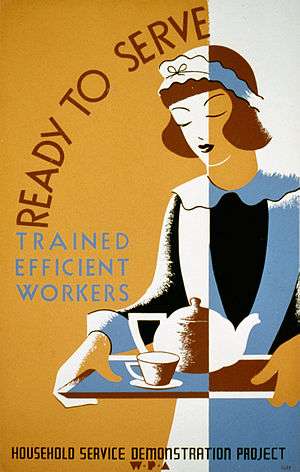Household Service Demonstration Project

The Household Service Demonstration Project (HSDP) was a Works Progress Administration (WPA) project designed to train women for domestic employment.[1]
History
The project was an offshoot of the Household Workers’ Training Program. The WPA announced the project in March 1937.[2] It got under way around July 1937[3] and ended it in January 1942.[4] The project was formally authorized by United States Congress in 1938. It offered training and employment in WPA training centers[5] giving demonstrations of housework.[6] The WPA designed it to promote the employment of women certified as qualified for private household employment and to promote the techniques of household service.[7]
Accomplishments
The project trained 30,000 women.[8] Middle-aged women were preferred due to the perceived unreliability and increased risk of marriage of younger women.[9] The project employed 1,700 women to give two- and three-month courses in cooking and serving food, house and child care, washing, ironing, and marketing.[10] Other skills taught included table setting,[9] home management, budgeting and knitting.[9]
The Program
In Washington, during the course of their training, trainees were paid $46 a month. After passing written and oral exams, diplomas were awarded to graduates.[11] After completing training, a graduate could make $60 a month as a domestic.[9]
Locations
Demonstration sites were located at 400 South Capitol Street in Washington, DC,[12] and at 217 E Boone Ave in Spokane, Washington.
Assessments
The HSDP was called Eleanor Roosevelt’s favorite project.[13] It was part of the WPA’s traditional emphasis.[14] The assistant state supervisor of seven household service projects in Pennsylvania was reported as saying, "There is something so obvious about a woman working in a home that I wonder why a project such as this wasn't begun many years ago."
References
- ↑ Abramovitz, Mimi (January 1996). Regulating the Lives of Women: Social Welfare Policy from Colonial Times to the Present. South End Press. p. 283. ISBN 978-0-89608-551-0. Retrieved August 4, 2013.
- ↑ "Wpa To Continue Domestic Training". Pqasb.pqarchiver.com. March 21, 1937. Retrieved January 31, 2011.
- ↑ The Personnel and Guidance Journal. American Association for Counseling and Development. 1938. Retrieved August 4, 2013.
- ↑ Final Report on the WPA Program, 1935-43. U.S. Government Printing Office. 1947. Retrieved August 4, 2013.
- ↑ Monthly labor review. 1940. Retrieved August 4, 2013.
- ↑ The Journal of Home Economics. American Home Economics Association. 1939. Retrieved August 4, 2013.
- ↑ Staff Study No.1-[19]. U.S. Government Printing Office. 1939. Retrieved August 4, 2013.
- ↑ Costa, Mariarosa Dalla (October 30, 2009). Dinero, perlas y flores en la reproducción feminista. Ediciones AKAL. p. 245. ISBN 978-84-460-2716-4. Retrieved August 4, 2013.
- 1 2 3 4 "WSU Libraries : Item Viewer". Content.wsulibs.wsu.edu. August 8, 1937. Retrieved January 31, 2011.
- ↑ Kelley, Mary (1979). Woman's Being, Woman's Place: Female Identity and Vocation in American History. Hall. ISBN 978-0-8161-8324-1. Retrieved August 4, 2013.
- ↑ "WSU Libraries : Item Viewer". Content.wsulibs.wsu.edu. July 25, 1937. Retrieved January 31, 2011.
- ↑ Hearings. 1939. Retrieved August 4, 2013.
- ↑ "WSU Libraries : Item Viewer". Content.wsulibs.wsu.edu. August 25, 1937. Retrieved January 31, 2011.
- ↑ "Table of Contents — March 2009, 95 (4) — Journal of American History". Historycooperative.org. March 1, 2009. Retrieved January 31, 2011.